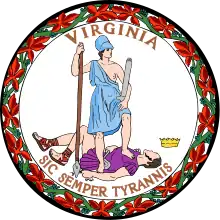Lieutenant Governor of Virginia
The Lieutenant Governor is a constitutional officer of the Commonwealth of Virginia. The Lieutenant Governor is elected every four years along with the Governor and Attorney General. The office is currently held by Democrat Justin Fairfax. The governor and lieutenant governor are elected separately and thus may be of different political parties. The lieutenant governor's office is located in the Oliver Hill Building on Capitol Square in Richmond, Virginia. The lieutenant governor serves as the President of the Senate of Virginia and is first in the line of succession to the governor; in the event the governor dies, resigns, or otherwise leaves office, the lieutenant governor becomes governor. Unlike the governor, the Lieutenant Governor of Virginia can serve consecutive terms.
| Lieutenant Governor of the Commonwealth of Virginia | |
|---|---|
 Seal of the Commonwealth of Virginia | |
| Style | The Honorable |
| Term length | Four years |
| Inaugural holder | Shelton Leake |
| Formation | 1852 |
| Website | www.ltgov.virginia.gov/ |
Since the late 1920s, the lieutenant governor has been one of only three positions that competes in a statewide election in Virginia (along with the governor and attorney general). Since the governor cannot serve consecutive terms, whoever is elected lieutenant governor is almost always considered a leading candidate for governor. This is especially the case if the lieutenant governor and the attorney general come from different parties. For example, after Democrat Tim Kaine was elected lieutenant governor and Republican Jerry Kilgore was elected attorney general in 2001, it was virtually taken for granted that they would face each other in the 2005 election.
The office of Lieutenant Governor is of colonial origin and can be traced to the Virginia Council of London. The Council was appointed by the King, and in turn, the Council appointed the Lieutenant Governor or deputy. When the English crown forbade colonial governors' absence from the colonies without leave in 1680, it became the Council’s duty to designate or send a deputy who could exercise all the powers of the Governor under the written instructions of both the crown and the Governor. Virginia’s first Constitution, adopted in 1776, provided a Council of State from which a President was annually selected from its members. The President acted as Lieutenant Governor in the case of the death, inability, or necessary absence of the Governor from the government. The Virginia Constitution of 1851 abolished the Governor’s Council of State and provided for the popular election of the Lieutenant Governor. Shelton Farrar Leake, from Albemarle County, was the first elected Lieutenant Governor, serving from 1852 to 1856.
Constitutionally, the Lieutenant Governor is president of the Senate of Virginia, as is the case with many other lieutenant governors in the United States. Unlike many of his counterparts, the Lieutenant Governor regularly presides over Senate sessions rather than delegating this role to the president pro tempore or majority leader.
List of Lieutenant Governors of Virginia
- Parties
No party/Conservative (3) Democratic (29) Whig (2) Republican (7)
Living former Lieutenant Governors of Virginia
As of August 2020, six former lieutenant governors of Virginia were alive, the oldest being Douglas Wilder (served 1986–1990, born 1931). The most recent death of a former lieutenant governor of Virginia was that of John H. Hager (served 1998–2002, born 1936), on August 23, 2020. He is also the most recently serving lieutenant governor of Virginia to die.
| Lt. Governor | Lt. Gubernatorial term | Date of birth (and age) |
|---|---|---|
| Chuck Robb | 1978–1982 | June 26, 1939 |
| Douglas Wilder | 1986–1990 | January 17, 1931 |
| Don Beyer | 1990–1998 | June 20, 1950 |
| Tim Kaine | 2002–2006 | February 26, 1958 |
| Bill Bolling | 2006–2014 | June 15, 1957 |
| Ralph Northam | 2014–2018 | September 13, 1959 |
.jpg.webp)